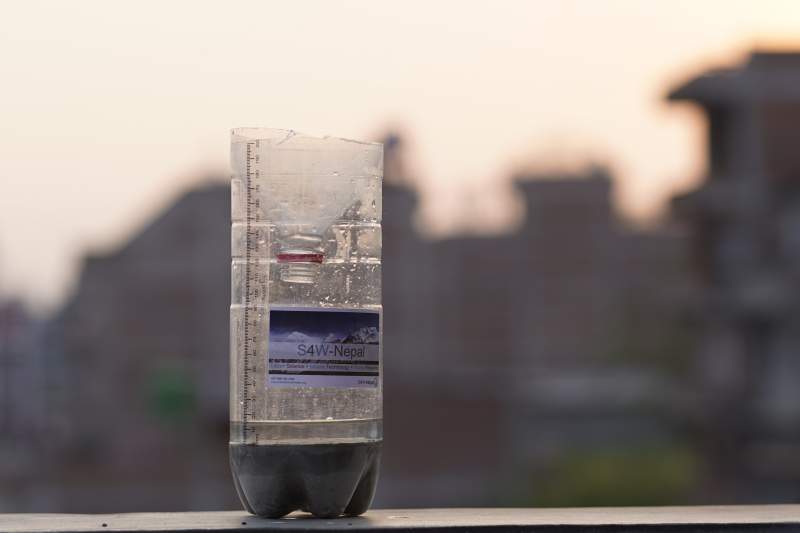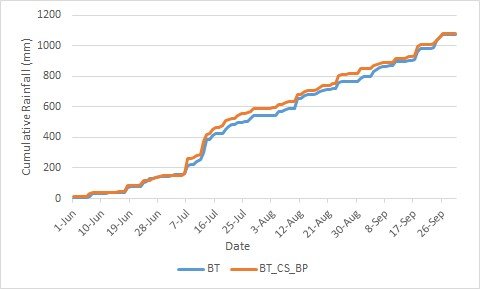Citizen science is an approach to science that engages and includes the general public in scientific research, which has the benefits of connecting the general public with professional scientists and increasing their scientific understanding (Keyles, 2020). Smartphones For Water Nepal (S4W-Nepal) appreciates these benefits and employs this approach. For more than four years S4W-Nepal has conducted the Monsoon Expedition in the Kathmandu Valley (Valley) by mobilizing citizen scientists, mobile technology, and young researchers to measure precipitation during the monsoon (roughly May to September). The citizen scientists use a cost-effective rain gauge and an android phone to perform daily rainfall measurements. The S4W-Nepal rain gauge is made of recycled clear plastic bottles (Coke or Fanta) of 2.15 liters having a uniform diameter of 100 mm, a concrete base, and a ruler with millimeter gradations (Figure 1).

For the 2019 Monsoon Expedition, S4W-Nepal recruited and trained 55 enthusiastic citizen scientists to monitor rainfall in different parts of the Valley. Through this, a good set of spatial rainfall data from May to September of 2019 of the Valley was generated. In 2019, the monsoon entered Nepal in the third week of June (DHM, 2019). Heavy rainfall was observed in July in the Valley which triggered flooding in several rivers, adversely affecting the settlements near the river corridors (Uprety, 2019). In order to understand the spatio-temporal variation of rainfall in the Valley, the daily rainfall measurements recorded by the CS (after quality control) were considered and a spatial map (May-September) was prepared by interpolating the CS point coverage to a continuous valleywide coverage (Figure 2). The data generated by citizen scientists show that rainfall was highest in the month of July (mean= 417.63 mm), followed by September (mean = 287.68) and August (mean = 250.44 mm) (Figure 2).
According to Davids et al. (2019), the S4W rain gauge used by citizen scientists for taking rainfall measurements is estimated to have an error of 2.9% compared to a standard Department of Hydrology and Meteorology (DHM) gauge. As an additional evaluation of the citizen scientists’ rainfall data from the S4W rain gauge in comparison to the DHM gauge, the CS stations located near the DHM stations (i.e., co-located stations) were chosen by generating Thiessen polygons in QGIS and identifying polygons with both a DHM gauge and CS station. Then, 17 co-located stations resulting from this process were selected to directly compare with the standard DHM rain gauge in the Valley. Only overlapping data from May to September 2019 were used for statistical comparison. The data of citizen scientists were correlated with the respective DHM stations based on Pearson correlation coefficient method to determine their relationship. The correlation between 10 co-located stations was found to be strong (above 0.60), 5 co-located stations were moderate (between 0.40-0.59), and 2 co-located stations were weak (below 0.39). The correlations for all stations were statistically significant at 0.01 significance level except for two; differences at the two stations may be due to greater distances between DHM and CS stations in these locations (~1.5 km for Sakhnu and ~0.5 km for Naikap). The times series of cumulative rainfall suggests that there is a similar trend of rainfall in both DHM and citizen scientists’ stations (Figure 3).

These results demonstrate that citizen science can be a feasible approach for collecting reliable rainfall data, along with educating the citizen scientists about the need and applications of hydrometeorological data. Also, the simple and cost-effective S4W-Nepal rain gauge is accurate enough to generate reliable rainfall measurement data. Therefore, citizen scientist networks should be further expanded to other regions in Nepal to fulfill the hydro-meteorological data gaps that exist. Furthermore, citizen scientists should be educated, trained, and motivated to complete regular rainfall measurements since these data can have a big impact in the field of research and support better water resource management decisions, along with raising awareness with citizens about the complexity and value of managing this precious resource.
References
Davids, J. C., Devkota, N., Pandey, A., Prajapati, R., Ertis, B. A., Rutten, M. M., Lyon, S. W, Bogaard, T. A. and Giesen, N. V. (2019) Soda Bottle Science—Citizen Science Monsoon Precipitation Monitoring in Nepal. Frontiers in Earth Science [online]. 7. Available from DOI: 10.3389/feart.2019.00046.
DHM (2019). Monsoon Onset and Withdrawal date information. Available from URL: https://www.dhm.gov.np/uploads/climatic/79118284monsoon%20onset%20n%20withdrawal%20English%20final.pdf.
Uprety, M. (2019) A dramatic start to Nepal’s 2019 monsoon season [Blog]. Available from URL: https://floodresilience.net/blogs/a-dramatic-start-to-nepals-2019-monsoon-season.
Keyles, S. (2018) CITIZEN SCIENCE: AN IMPORTANT TOOL FOR RESEARCHERS. Science Connected Magazine.


